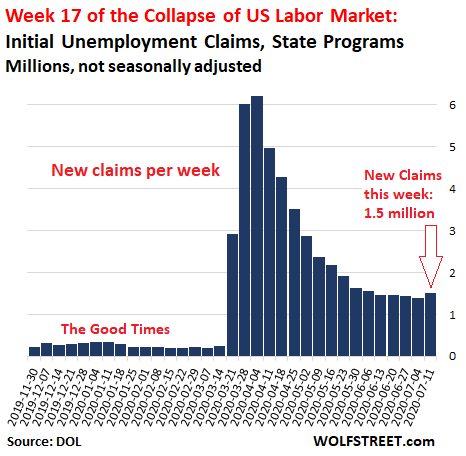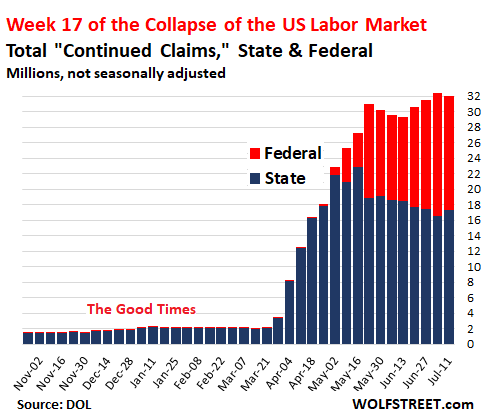32 Million People on State & Federal Unemployment, 2nd Highest Ever: Week 17 of U.S. Labor Market Collapse
by Wolf Richter, Wolf Street:
 Torrent of 2.4 million new claims under state & federal programs this week. PUA claims by gig workers now 45% of 32 million in total unemployment. Many people are hired back, but many people are newly laid off. Labor market recovery remains hard to discern.
Torrent of 2.4 million new claims under state & federal programs this week. PUA claims by gig workers now 45% of 32 million in total unemployment. Many people are hired back, but many people are newly laid off. Labor market recovery remains hard to discern.
The torrent of newly laid-off workers keeps flowing into state unemployment offices to claim unemployment at an astounding rate week after week. But many people who were claiming unemployment benefits in prior weeks were called back to work, or found new work. And the total number of people who continued to claim unemployment compensation in the week ended July 11 under all state and federal unemployment insurance programs, including gig workers and contract workers, dipped by 433,000 to 32.0 million (not seasonally adjusted), according to the Department of Labor this morning. It was the second highest level ever, after last week’s gut-wrenching record.

Unemployment insurance under state programs.
It’s not getting better: 1.50 million people who were newly laid off filed their initial unemployment claims with state unemployment offices in the week ended July 11, up from 1.40 million people who’d filed their initial claims in the week before.
Over the past five weeks, these initial state unemployment claims totaled 7.25 million, for an average of 1.45 million per week, which shows how relentlessly companies have shed workers week after week.
Early on in the crisis, it became clear that the seasonal adjustments were not designed for this huge explosion in unemployment, and caused the “seasonally adjusted” initial claims to be over-reported by the millions. This is when I started reporting only “not seasonally adjusted” unemployment data – and this is what you’re seeing here, the unadjusted data.

These 1.5 million people who just lost their jobs and filed their initial unemployment claims represent the new inflow into the pool of the unemployed under state unemployment programs.
But millions of people who had been laid off in prior weeks and who had already claimed state unemployment insurance have gotten their jobs back, or found new jobs. And those people represent the outflow of the pool of the unemployed.
In recent weeks, this outflow was higher than the weekly inflow, and the number of people continuing to receive state unemployment insurance, the “insured unemployed” under state programs, declined.
But this week, the number of the insured unemployed rose to 17.4 million, the first weekly increase since mid-May (the blue columns in the first chart above).
Unemployment insurance under federal programs.
Pandemic Unemployment Assistance (PUA), which covers contract workers and self-employed – the “gig workers” – which includes everyone from rideshare drivers to tech specialists working on a contract basis: 928,488 initial claims were processed by 48 states in the week ending July 11. This is the weekly inflow into the mass of gig workers who lost their work and are claiming benefits under this program.
In total, 14.3 million contract workers continued to claim benefits under the PUA program, accounting for 45% of all people continuing to claim benefits under state and federal unemployment programs.
Two states – New Hampshire and West Virginia – still have not figured out how to process these PUA claims.
State and federal new claims combined: 1.5 million initial state claims plus 928,488 PUA claims amount to an inflow of 2.4 million into the pool of the unemployed for the week!
Pandemic Emergency Unemployment Compensation (PEUC), covers people who don’t qualify for regular state unemployment insurance or for PUA: 936,431 people continue to receive benefits under this program. Nine states still have not yet processed any PEUC claims.
These unemployed workers under the PUA and PEUC programs, plus workers under programs for federal employees and newly discharged veterans, plus workers covered by all remaining programs combined are shown by the red columns in the first chart above.
Unemployment Crisis triggers Data Chaos.
The unprecedented surge of millions of people who suddenly lost their work and continue to lose their work came together with a slew of new programs that Congress enacted to support workers that would not normally qualify for state unemployment insurance.


